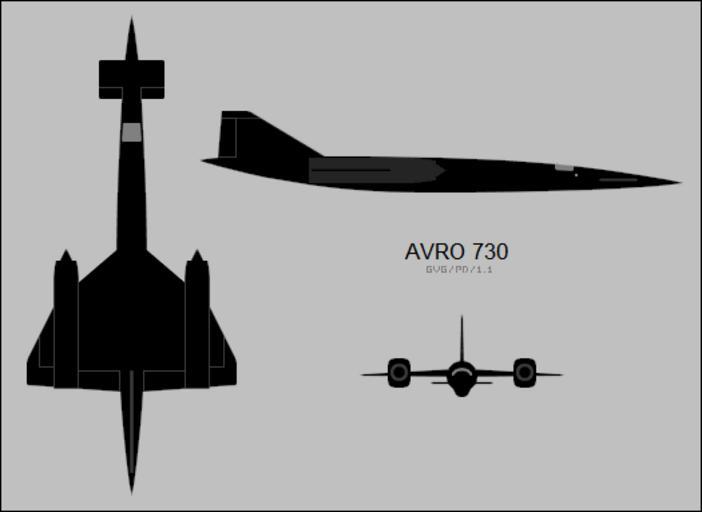In the 1960s, Britain was all set to launch, what could have been, the world’s first spy plane with Mach 3 speed, Avro 730. But then, something happened and the US’ legendary SR-71 Blackbird stole the show.
Why Modi Doesn’t Need Indian Diaspora’s Stamp Of Approval On His Policies
The Avro 730 was destined to become the first supersonic reconnaissance aircraft and strategic bomber. During the 1950s and 1960s, Britain was among the nations looking to field super-fast spy planes that could cater to the requirements of reconnaissance and bombing.
However, it was the US, which actually went ahead with its plan and launched a spy plane that boasted an incredible speed.
Washington gave the contract to aerospace giant, Lockheed Martin, during the Cold War to develop the Blackbird SR-71 spy plane, which remains to date, the fastest plane ever on the face of the planet.
The Blackbird was a long-range, high-altitude, Mach 3 + strategic reconnaissance aircraft secretly designed in the late 1950s for operations by the US Air Force and NASA (National Aeronautics and Space Administration).
Now retired, the aircraft was built by the US to enter the enemy territory without being detected at a time when no satellite or drones existed. According to CNN, the extremely fast plane could cruise near the edge of space and could even outfly a missile.
However, things could have been a lot different if Britain had its way. While the US Air Force first deployed the Blackbird in January 1966, Britain was preparing to fly their high-altitude, supersonic reconnaissance Avro 730 aircraft as early as 1965.
The idea to develop the Avro 730 spy plane was put to paper even before the birth of intercontinental ballistic missiles (ICBMs).
In order to provide significant support to its force of nuclear-armed ‘V’ bombers — the Valiant, Victor and Vulcan — the Royal Air Force (RAF) communicated its need for a high-altitude, long-range reconnaissance jet that could fly at a speed of at least Mach 2.5 (1,918 miles per hour).
Following its request, the Stockport-headquartered Avro Aircraft, which was the manufacturer of the Vulcan bomber as well as the World War II legendary Lancaster bomber, was awarded a development contract for the spy plane in 1955.
Originally envisioned as a very high-speed aircraft with the capability of performing aerial reconnaissance missions, Avro later decided to modify the aircraft’s design to arm it with nuclear weapons.
According to Tony Butler’s book, British Secret Projects: Jet Bombers Since 1949, the aircraft’s maximum altitude would have been 66,000 feet, with the maximum range being 4,280 nautical miles at a top speed of Mach 2.5.
The entire weight of a fully-fuelled Avro 730 would be around 146 tons, with half the aircraft’s weight taken up by fuel.
Besides, the two-man crew would be seated in a cockpit that only had two small side-facing windows, with the pilot relying on a retractable periscope for visibility during takeoff and landing.
The four-turbojet Avro 730 would have physical resemblances to America’s Blackbird, with a long, slender fuselage, except that the 730 had canards—mini-wings—near the nose.
While the Blackbird was developed using lightweight, heat-resistant and expensive titanium, the 730 was built using old-fashioned materials.
“Avro based the 730’s structure on high tensile steel since this permitted the specified Mach 2.5, arguing that its known and reliable properties offset the shorter development time of light alloy; it also offered possible development to even higher Mach numbers,” writes Butler.

While the 730 indeed had huge potential, especially in terms of increasing its speed, the plan to develop them was scrapped even before it could leave the drawing board.
According to the British White Paper on Defense in 1957, the conclusion was that the aircraft would have been vulnerable to surface-to-air missile attacks.
Officials in the British Defense Ministry felt that the future belonged to nuclear-armed ballistic missiles, leading to the cancellation of the Avro 730.
“Had the winning Avro 730 been completed and flown it would have been a major achievement but, once again, significant advances in the development of defensive Soviet surface-to-air guided weapons quite literally brought everything down to earth and made the 730, at least in British eyes, an outdated and obsolete concept,” Butler wrote in his book
“The Avro 730 had much in common with the American Lockheed SR-71 Blackbird and predated it by a year or two. Early American studies looked similar to some of the designs described in this chapter but America saw its program through to fruition and the SR-71 served for many years,
“Whether Britain should have completed its machine, and would it have been worth the cost, is an argument that most likely will never be settled.”
Follow EurAsian Times on Google News




